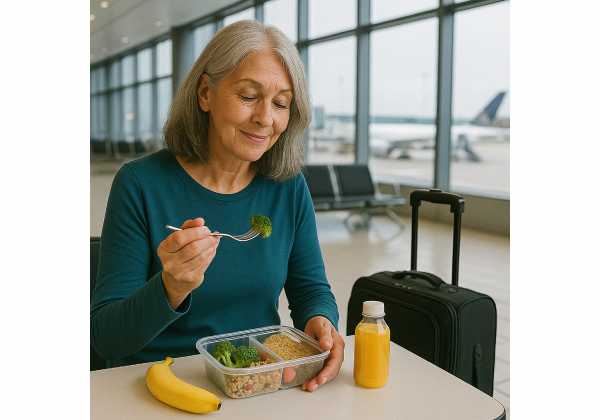
Travel often means long lines, dry air, and unpredictable food—yet your choices in those few rushed minutes can keep energy steady, digestion calm, and sleep on track. The goal is not perfection; it is control over the predictable stressors of travel days: sodium-heavy grab-and-go options, long gaps between meals, and late dinners in new time zones. This guide shows you how to pack compact protein and fiber, choose reflux-friendly foods for flights, and set up a hotel room so breakfast and snacks take care of themselves. You will also learn a simple restaurant playbook by cuisine, food safety rules for planes and minibars, and a plan to reset your body clock with meals and light. If you want a bigger framework to plug these tactics into, see the fundamentals of long-term eating patterns on nutrition for longevity foundations.
Table of Contents
- Airport Strategy: Portable Protein, Fiber, and Hydration
- Plane Friendly Foods and Timing to Minimize Reflux
- Hotel Room Setup: Mini Fridge Staples and Utensils
- Restaurant Playbook by Cuisine When on the Road
- Food Safety and Storage on Travel Days
- Jet Lag and Meal Timing: Resetting Your Clock
- Sample Travel Day Menu and Packing List
Airport Strategy: Portable Protein, Fiber, and Hydration
Airports sell calories, not satiety. The winning strategy is to carry a small kit that provides portable protein, fibrous bulk, and controlled sodium, then use the terminal to top up produce and fluids.
Pack a “PFP” kit (Protein-Fiber-Portable).
- Protein: shelf-stable options that are TSA-friendly—individual tuna or salmon pouches, roasted soybeans or chickpeas, beef or turkey sticks (aim for ≤400 mg sodium per stick), single-serve nut butter, shelf-stable tofu, or a shaker with measured protein powder.
- Fiber: portioned bags of nuts and seeds (almonds, walnuts, pumpkin seeds), oat packets, roasted chickpeas, high-fiber crackers, or a small container of chia/flax to stir into yogurt later.
- Portable extras: a travel spork, folding knife (in checked bag), two 1-quart zip bags (ice-bath improviser for hotel room), and a collapsible bottle.
Use the terminal to add produce and hydration.
Most airports now offer fresh fruit cups, bananas, cut vegetables, and plain yogurt. Buy water after security and sip 200–250 mL every hour while in the terminal. If you crave something flavored, choose sparkling water and add a slice of citrus. Coffee and tea are fine; avoid large sugary drinks that create a blood sugar spike followed by an energy crash mid-flight.
Strategize sodium.
Many “healthy” airport items—wraps, soups, and premade salads—run 800–1,200 mg sodium per package. If you buy one, balance it with lower-sodium sides (fruit, yogurt) and plan a low-sodium dinner. Use condiments lightly; most packets add 150–300 mg.
Buy smarter from common chains.
- Breakfast: plain Greek yogurt with nuts and fruit; oatmeal with nuts; egg bites without cheese-heavy sauces.
- Lunch/dinner: grilled chicken or bean bowls, brown rice on the light side, extra vegetables, salsas over creamy dressings.
- Snacks: fruit, unsalted nuts, dark chocolate, air-popped popcorn.
Timing and gaps.
If your flight plus commute plus hotel check-in totals more than six hours, do not rely on airline snacks. Eat a balanced meal one to two hours before boarding and carry a second mini-meal for the connection (e.g., tuna pouch + whole fruit + crackers).
Move and breathe.
A five-minute walk every hour improves circulation and helps digestion. If you are prone to swelling, compression socks reduce ankle edema on longer trips.
Plane Friendly Foods and Timing to Minimize Reflux
Cabin pressure, tight seats, and slouched posture make reflux more likely. Add carbonated alcohol, heavy sauces, and late-night arrivals, and heartburn can follow you the entire trip. You can fly comfortably by adjusting meal size, content, and timing.
Keep portions modest and protein anchored.
Large, fatty meals linger in the stomach and raise the risk of reflux. Opt for a protein-plus-produce pattern: grilled chicken or tofu with vegetables; a bean-and-grain bowl with extra greens; yogurt with nuts and berries. Limit rich sauces, fried items, and extra cheese before and during flights.
Choose low-acid, low-gas items on board.
- Friendly options: bananas, oatmeal, plain yogurt, nut butter, turkey or tofu sandwiches on moderate-fiber bread, simple salads with olive oil and lemon (go light on raw onions and peppers), broth-based soups when available.
- Caution list: tomato-heavy sauces, very spicy foods, garlic-laden dressings, raw alliums, carbonated sodas, and large chocolate portions close to boarding.
Time the last significant meal.
Aim for your last larger meal 2–3 hours before takeoff. During the flight, use small, frequent snacks if hungry rather than one big tray. On red-eyes, eat the main meal earlier in the evening and keep the in-flight snack very light (e.g., yogurt or a banana with a few nuts).
Beverages and caffeine.
Hydrate with water and unsweetened tea. Limit high-caffeine drinks late in the day; they can reduce lower esophageal sphincter tone and disrupt sleep on arrival. Alcohol dehydrates and increases reflux risk; if you drink, keep it to one serving and pair with water and food.
Posture and movement.
Avoid deep slouching. Use a small pillow or rolled jacket to keep the upper back supported, and walk the aisle when the seatbelt sign is off. Standing for two minutes after snacks or meals aids gastric clearance.
Medication planning.
If you use acid suppression (e.g., a proton pump inhibitor), take it consistently and at the right time relative to meals. For occasional heartburn, carry antacids in your personal item. For a deeper dive on trigger foods and meal sizing, see our practical guide to reducing reflux while eating out.
Hotel Room Setup: Mini Fridge Staples and Utensils
Your room can function like a small studio kitchen with a five-minute setup. The aim is to cover breakfast, one snack, and “insurance” items in case a dinner plan falls through.
Call ahead (or check the app).
Confirm: mini fridge, microwave or kettle, ice machine, and whether the hotel can supply a bowl, spoon, and knife. If not, bring a travel utensils kit: compact cutting board, foldable knife (checked baggage), metal spoon/fork, a small lidded bowl, and two food-safe containers.
First stop near the hotel: a small grocery run.
- Protein anchors: Greek yogurt cups, skyr, cottage cheese (if tolerated), hard-boiled eggs, smoked salmon, shelf-stable tofu, or pre-cooked chicken.
- Produce: berries, bananas, cherry tomatoes, spinach/arugula (for quick salads), baby carrots, sugar snap peas.
- Smart carbs: pre-cooked rice cups, microwaveable quinoa, whole-grain pitas or tortillas, high-fiber crackers, oats.
- Healthy fats: olive oil mini, avocado, nuts, seeds, single-serve hummus.
- Flavor and function: lemon or lime, pepper grinder, cinnamon, small hot sauce, herbal tea.
- Hydration: water, mineral water, or low-sugar electrolytes if arriving from heat or altitude.
No-cook breakfasts and five-minute dinners.
- Breakfasts:
- Yogurt + berries + chia, or oats soaked overnight in the mini fridge.
- Whole-grain wrap with egg and spinach (microwave or kettle steam method for eggs if safe and allowed).
- Dinners:
- Grain bowl: quinoa cup + arugula + canned beans + olive oil + lemon + nuts.
- “Tapas plate”: smoked salmon or tofu, whole-grain crackers, hummus, tomatoes, olives (rinse brine to reduce sodium).
Sodium management away from home.
Hotel snacks and minibar items skew salty. Keep unsalted nuts, fruit, and low-sodium crackers visible on the desk. If you buy pre-made soups or frozen meals, choose options ≤600 mg sodium per serving and add a side salad to dilute total sodium per meal.
Food-storage habits in the room.
Label leftovers with date/time, store within two hours of purchase, and keep cold foods ≤4 °C (40 °F) when possible. Use the top shelf of the mini fridge where temperature is most stable, and avoid the door for dairy or fish.
For a broader blueprint you can reuse after this trip, see our modular system for batch-cooking and make-ahead staples that translate well to hotel rooms.
Restaurant Playbook by Cuisine When on the Road
Eating out is part of travel. The key is to keep structure (protein + produce + smart carbs + healthy fat) while enjoying local flavors. Use these order templates and swaps across common cuisines.
General moves first
- Open with a salad, broth-based soup, or grilled vegetables to set volume and fiber.
- Choose a protein that is grilled, baked, broiled, or sautéed rather than fried.
- Ask for sauces and dressings on the side and use citrus, herbs, and olive oil to finish.
- Split starch portions or choose a legume-rich side when available.
Cuisine-specific templates
- Mediterranean: grilled fish or chicken souvlaki, large Greek salad (light on feta and olives if watching sodium), lentil or bean dishes, whole-grain pita on the side.
- Japanese: sashimi or sushi with salmon/tuna, edamame, seaweed salad; minimize tempura and heavy mayo sauces. Choose miso soup and steamed rice; share soy sauce and go easy if sodium sensitive.
- Thai/Vietnamese: rice-paper rolls, green papaya salad, grilled meats, stir-fries with extra vegetables. Request “less sauce” and pick curries with lean protein; ask for lime and herbs to brighten.
- Indian: tandoori meats, chana masala, dal, baingan bharta; choose plain rice or whole-wheat roti over rich naan and creamy gravies.
- Mexican/Tex-Mex: grilled fish or chicken tacos, fajitas with extra peppers and onions, black or pinto beans. Load salsa and pico; go light on queso and sour cream.
- American grill: salmon or lean steak with double vegetables; swap fries for a baked potato with olive oil and chives.
Breakfast on the road
Scrambles or omelets with vegetables, oatmeal with nuts and fruit, yogurt bowls, or a smoked salmon plate with tomatoes and capers. Skip the pastry default unless it is your planned treat.
Alcohol and desserts
Set a personal rule before you sit down: either a drink or dessert, not both, most nights. If you do enjoy wine or beer, hydrate and pair with food. Curious about how alcohol fits a longevity pattern? See our summary on evidence-based drinking limits.
Airline lounges
Build a plate from raw vegetables, olives (rinse if possible), hummus, hard-boiled eggs, fruit, and a small portion of whole grains. Save creamy soups, sliders, and sugary desserts for a deliberate treat.
For more restaurant-specific strategies, including airport food courts, see smart ordering on the road.
Food Safety and Storage on Travel Days
Food safety risks rise when meals sit in warm environments, change hands often, or travel long distances. A few rules protect your trip—and your gut.
The two-hour rule.
Perishable foods should not sit at room temperature for more than two hours, or one hour if ambient temperatures exceed 32 °C (90 °F). This includes airport delays and hotel check-in lines. If you cannot refrigerate within that window, choose shelf-stable options until you reach your room.
Cold chain basics.
- Insulation: use a soft-sided lunch bag with a small ice pack or freeze a water bottle overnight (hotel freezer or ice bucket hack).
- Placement: in the plane, keep perishable items under the seat rather than in a warm overhead bin.
- Mini fridge discipline: store ready-to-eat items (yogurt, salads, cut fruit) on upper shelves; raw fish or meat near the bottom, well sealed, and for same-day use only.
Smart choices at altitude.
Skip foods that rely on perfect temperature control when you cannot confirm handling (e.g., cream-filled pastries, deli salads heaped high). Pre-wrapped sandwiches from reputable vendors are safer than open-case items that have sat uncovered.
Leftovers and reheating.
If you bring back restaurant leftovers, refrigerate within two hours, reheat to steaming, and finish them within 24 hours. Avoid reheating seafood more than once; quality and safety drop quickly.
Drinks and ice.
Airports and hotels in most countries supply safe drinking water, but use your judgment when abroad or in older facilities. When uncertain, choose sealed bottled water and avoid ice made from tap water. Clean your travel bottle daily with hot water and a drop of dish soap; let it air dry.
Hand hygiene and surfaces.
Carry alcohol-based hand gel (≥60% alcohol) and use it before eating when a sink is not available. Wipe the tray table and arm rests before snacking; they are high-touch surfaces.
For deeper detail tailored to older adults and those with medical conditions, see our concise checklist for safer shopping and storage.
Jet Lag and Meal Timing: Resetting Your Clock
Crossing time zones disrupts sleep, appetite, and digestion. Light is the strongest signal for your body clock, but meal timing can speed adaptation and reduce the groggy “day three slump.”
Before you go (two to three days).
- Edge your schedule. Shift bedtime and wake time by 30–60 minutes toward the destination each day.
- Move meals accordingly. Slide breakfast and dinner in the same direction as sleep. This primes hormones involved in glucose control and appetite.
- Train the first meal. Make a habit of a protein-forward breakfast; this anchors energy and reduces late-day cravings after you land.
In transit.
- Adopt destination time on the plane. If you will land in the morning, keep the flight meal light and try to sleep during the destination night hours.
- Hydrate, limit alcohol. Dehydration worsens fatigue and constipation and can fragment sleep.
- Caffeine with purpose. Use it early in the destination morning only; avoid after local noon for eastward trips to protect your first-night sleep.
On arrival.
- Light and meals set the day. Get bright outdoor light during the local morning and eat a real breakfast even if you are not very hungry. A small, protein-rich meal—e.g., eggs and vegetables or yogurt with nuts—helps fix the new morning.
- Kitchen curfew. Keep dinner on the early side and finish eating at least three hours before local bedtime, especially if reflux-prone.
- Fasting windows, gently. If you feel constantly hungry at odd hours, try a 12-hour overnight food-free window for two or three days to retrain rhythms; do not force longer fasts during heavy travel.
Supplements and aids (optional).
Some travelers use melatonin for eastward trips; timing matters more than dose. Start with a small amount near the destination bedtime for a few nights. Focus first on light, movement, and food timing; these cues are powerful and side-effect-free.
Curious about how meal timing interacts with circadian biology? Our primer on chrononutrition explains how to align eating with your body clock across the week, not only on travel days.
Sample Travel Day Menu and Packing List
This sample itinerary shows how the pieces fit: portable protein, produce at the terminal, reflux-aware flight choices, and a simple hotel setup. Adjust portions to your needs.
Morning departure (domestic, three-hour flight)
- Home breakfast (2–3 hours before airport): spinach-mushroom omelet, whole-grain toast with avocado, berries, and water.
- Pack: tuna pouch, high-fiber crackers, two fruit pieces, unsalted nuts, protein powder in a shaker, collapsible bottle, travel spork, antacids if needed.
At the airport (60–90 minutes pre-boarding)
- Buy water and a plain Greek yogurt; mix in nuts. Walk five minutes, stretch, then board.
On the plane
- Skip soda and alcohol; sip water. If hungry, eat a banana and a small portion of crackers with the tuna pouch. Stay seated upright after eating and walk once mid-flight.
Arrival and hotel check-in
- Quick grocery run: yogurt, berries, salad greens, cherry tomatoes, hummus, whole-grain wraps, pre-cooked rice cups, smoked salmon or tofu, nuts, fruit, and herbal tea.
- Hotel dinner (five-minute bowl): rice cup + arugula + cherry tomatoes + smoked salmon + olive oil + lemon + pepper.
- Evening routine: light walk outside, gentle stretch, and lights out on the local schedule.
International red-eye (eastbound, six to eight hours)
- Evening at home airport: early dinner—grilled chicken or tofu, roasted vegetables, small baked potato.
- In-flight: keep it light; yogurt and berries or a small sandwich if needed. Wear compression socks, hydrate, and try to sleep.
- On arrival (morning): bright light and a protein-forward breakfast (eggs and vegetables or yogurt and nuts). Short walk, then a 20–30 minute nap if necessary, ending by early afternoon. Early dinner and an early bedtime help lock the new rhythm.
Restaurant templates for the week
- Lunch: soup and salad with a protein add-on; or tacos with grilled fish and extra pico.
- Dinner: grilled fish/chicken or legume-based entrée, double vegetables, whole grains on the side. Decide in advance: drink or dessert.
Minimalist packing list
- Shelf-stable protein (2–3 pouches), nuts/seeds (2–3 small bags), high-fiber crackers, two oat packets, travel utensil kit, collapsible bottle, small olive oil, lemon, spice mini (pepper/cinnamon), two food containers, zip bags, and hand gel. Optional: light electrolyte packets for hot destinations.
Troubleshooting on the road
- Constipation: raise water intake; add a kiwi or two and a serving of oats or beans daily; walk after dinner. For a deeper plan, see gentle fixes for regularity.
- Cravings: verify protein at breakfast and lunch; carry nuts or roasted chickpeas for late afternoons. If cravings persist, see our tips in steadying appetite while traveling.
- Blood sugar dips: place protein at every snack (nuts with fruit, yogurt with seeds) and keep sweet drinks to a minimum; see flattening spikes with food choices.
References
- Dietary Guidelines for Americans, 2020-2025 2020 (Guideline)
- Food and Water Safety 2024 (Guidance)
- ACG Clinical Guideline: Guidelines for the Diagnosis and Management of Gastroesophageal Reflux Disease 2022 (Guideline)
- Jet lag and sleep 2024 (Guidance)
Disclaimer
This guide provides general nutrition and food safety information for travel and is not a substitute for personalized medical advice. Travelers with chronic conditions—such as diabetes, kidney disease, inflammatory bowel disease, or food allergies—should review individual plans with their healthcare professional before departure. Always follow local health advisories, check medication storage requirements, and seek medical care for persistent vomiting, high fever, blood in stool, severe dehydration, chest pain, or shortness of breath.
If this article helped you travel better, we would appreciate it if you shared it on Facebook, X, or your preferred platform, and followed us for future updates. Your support helps us continue producing practical, evidence-based resources for healthy aging.










